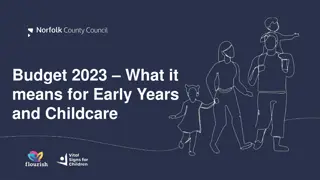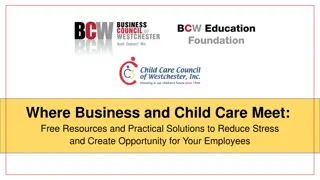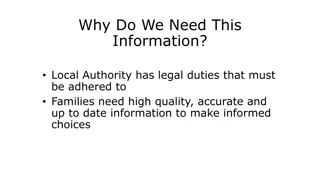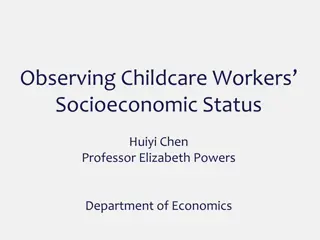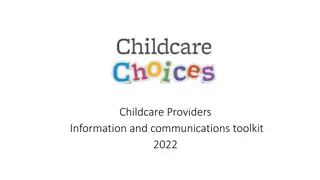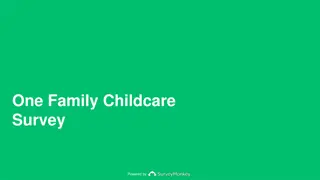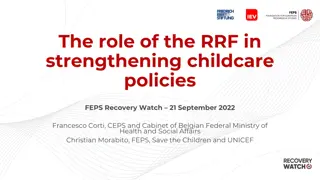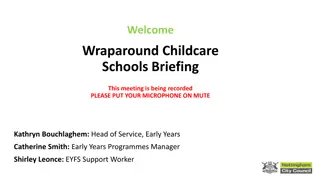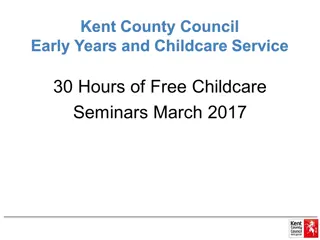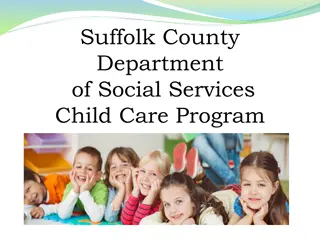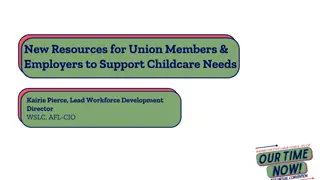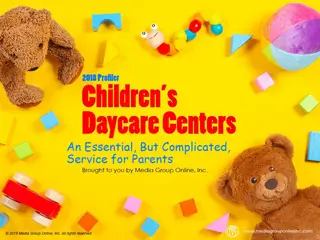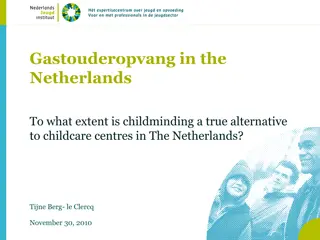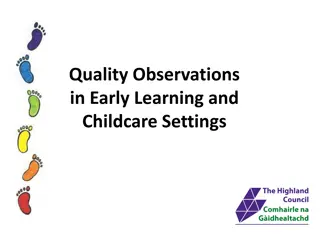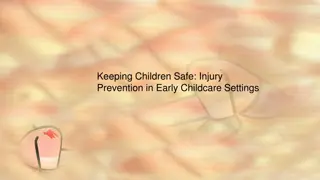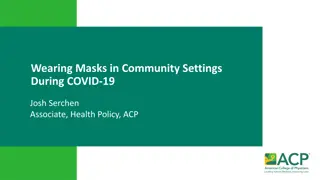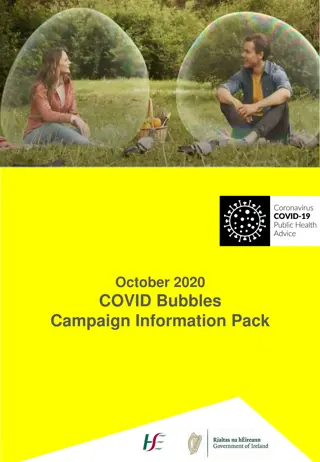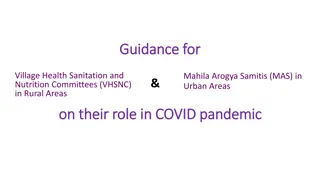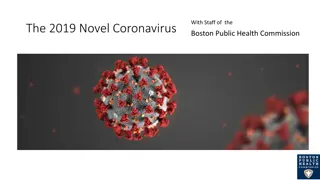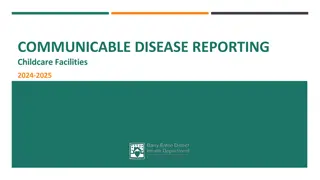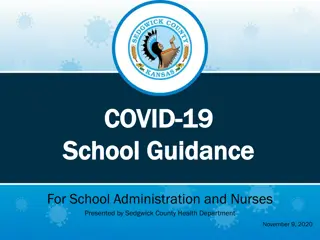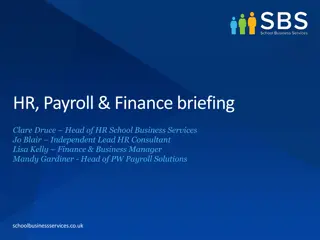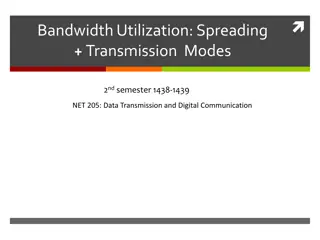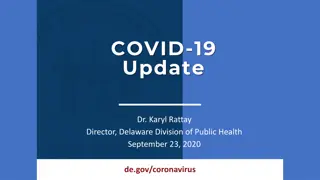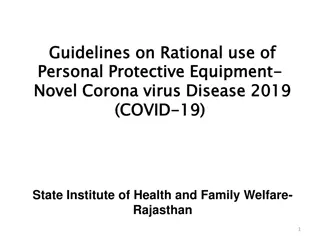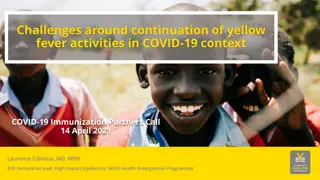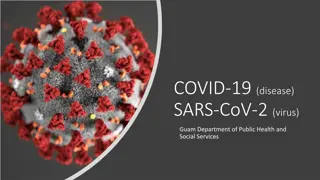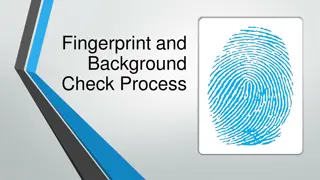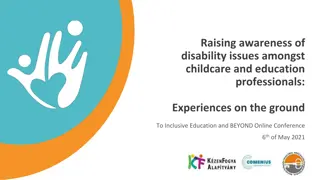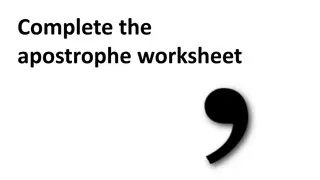Understanding COVID-19 Risk and Spread in Childcare Settings
This content provides guidance on COVID-19 infection prevention and control in childcare settings by exploring risk factors, spread mechanisms, and the nature of the COVID-19 virus. It discusses the importance of aerosols and droplets, the lipid coat of the virus, and how the virus spreads through close contact and contaminated surfaces. The information highlights the significance of proper hand hygiene and cleanliness in preventing the spread of COVID-19.
Download Presentation

Please find below an Image/Link to download the presentation.
The content on the website is provided AS IS for your information and personal use only. It may not be sold, licensed, or shared on other websites without obtaining consent from the author. Download presentation by click this link. If you encounter any issues during the download, it is possible that the publisher has removed the file from their server.
E N D
Presentation Transcript
COVID-19 IPC Guidance for Childcare Settings Presented by HSE Antimicrobial Resistance and Infection Control (AMRIC) Team Prof. Martin Cormican, HSE Clinical Lead for HCAI & AMR (martin.cormican@hse.ie) Mary McKenna, Infection Prevention and Control Nursing (mary.mckenna@hse.ie) @hpscireland 31st July 2020
Risk How we talk about and think about risk ? High/low/very low/ extremely low We will hardly ever say zero risk (life does not come with many guarantees)
Spread of COVID-19 The spread of COVID-19 is a lot like other respiratory virus Everyone scatters tiny particles of liquid when they talk, laugh, sneeze or cough The particles are in range of sizes larger ones call droplets/smaller ones called aerosols Droplets travel and short distance before landing Aerosols can stay in the air and spread throughout the room If someone has infection there can be virus in the droplets and aerosols Aerosols are very important for some virus measles /chickenpox Droplets are very important for some virus COVID-19 / Influenza
The COVID-19 VIRUS Lipid coat with protein spikes The lipid coat of the virus can be removed by alcohol hand rub, soap and detergent and household disinfectants Infection happens if virus spikes stick to to the lining of the respiratory tract (inside the mouth, nose or in the eye) In a person who is not immune (very few people are immune) The virus does not go through the skin
COVID-19 Risk of Spread Close contact with someone shedding the virus who is coughing /sneezing and droplets drop in mouth/nose/eyes When hand touch surfaces or objects someone with virus on it you can get virus on you hands if you touch you nose/eyes/mouth before you clean your hands thoroughly by either hand washing or cleaned with alcohol hand gel you can put the virus in you eyes/nose/mouth
Can COVID-19 spread in the air? COVID-19 is not like measles or chickenpox Droplets carry COVID-19 a short distance through air Does not usually spread well in aerosols through the air over long distances (not airborne) Being in the same big room but at a distances is very low risk Being in the same outdoor space is extremely low risk
Symptoms and period of infection The time between exposure to the virus and developing symptoms is most often five to six days but can range from 1 to 14 days People are most infectious in the early stages when they become symptomatic Infection can also spread from people a day or two before they develop symptoms Some people have very mild symptoms or no symptoms( don't consider themselves unwell) By 14 days from symptoms develop most people are not shedding the virus Severe Illness is more common and severe in older people than children and adults in good health Common symptoms include high temperature, cough, shortness of breath and loss of taste and smell
COVID-19 and Children May be less likely to catch infection Much less likely to get serious disease Less likely to spread infection than adults and older children Note: Less likely does not mean impossible - children do get infected, a small number get severe disease and infection can spread from children to others
Queries re: symptoms If a child is absent with a cough or a temperature, how long do they need to be symptom free before they return to the childcare service? It depends How do services identify and manage the symptoms of teething babies who will have a higher temperature and will be drooling to those of COVID-19? Teething is not generally accepted as a cause of a temperature greater than 38 How do services tell whether a child is experiencing an ordinary childhood illness vs Covid-19? It is very difficult Do they need to be sent home even if they only have one symptom of Covid-19? Generally yes use judgment
Testing for COVID-19 A test for COVID-19 is taken from a swab sample from the back of the nose and throat and sent to the laboratory (but looking at more child friendly options) Parents/guardians and staff concerned they have symptoms should: self isolate/ isolate the child phone their GP who will decide if testing needs to be arranged If someone is confirmed with COVID-19 the HSE works with people to identify close contacts who may be at a higher risk of developing infection Self isolation advised and test is offered to Contacts even if symptoms haven't developed
Queries received on testing Some services are concerned about testing and contact tracing taking too long and fear that this might be increasing the risk to staff/children. Why can t childcare practitioners/children in services be prioritised for testing? If a suspected case gets a negative result of a test back, are they ok to return to the service? (not-detected is a better word than negative) Some providers have told us of cases where the 14 day self-isolation period is up before the second test is conducted. Is it safe to go back to the service once the 14 days are up but before the second test? Generally yes
A way of thinking about controlling COVID-19 in any setting Harry Potter Fans Who said Constant Vigilance
Keeping the virus out Take all practical measures to ensure people with COVID-19 symptoms don't attend the childcare setting Promote awareness to staff and families on symptoms with posters and messages Advise staff not to attend work and self isolate if unwell or identified as a contact of COVID-19 Advise parents not to send their children if they or other household members have suspected or confirmed with symptoms On site temperature checking or checking temperature at home is not required as fever is not always present Follow government advice on travel and restriction of movement Promote good hand hygiene and respiratory etiquettes with posters and reminders in the facility - available on HPSC website ( www.hpsc.ie)
Managing the risk of COVID-19 Limit the extent of people mixing together Arrangements help to maintain distance between parents/guardians and childcare staff: Signage of pedestrian traffic flow and drop off points If child needs to be accompanied bring child to/near to the car if possible and parent guardian remain in car. Keep mixing of groups of people to the smallest number practical Drop off and pick up Use of pods in large settings is recommended to limit contact and sharing of common facilities between people
Pods Children and adults should try to remain in the same pod as much as they can Different pods should not share toys and should have separate breaks and meal times or separate areas at break and meal times Floating /relief staff members who move from pod to pod- as little as practical Where practical, children from the same household should be in the same pod A record should be retained of the people (children and carers) in each pod on each day to facilitate Contact Tracing in the event of an episode of infection
Size of Pods There is no evidence base on which to define a maximum pod size. Guidance is based on keeping pod sizes as small as is likely to be reasonably practical This is not a rule set it is guideline apply the principle For example a pod size of 8 to 12 (2 to 3 adults and 6 to 9 children) may be practical for children aged less than 1 year
Queries received regarding PODS How often can pods be changed? As infrequently as you can practically manage For example, if 10 children attend on a Monday and on a Tuesday 5 of the same children from Monday attend as well as 5 different children the pod 15 children or is it the Monday pod of 10 children and Tuesday pod of 10 children? The goal is to keep the pods as stable as you can the pod may be thought of as 15 with not everyone present every day but what want to avoid is those 5 children going randomly into different pods any day they attend
Queries received regarding PODS How often can pods be changed? The more pods mix the less value there is in the concept Are parents required to be informed of mixing of pods? - part of the overall communication with parents about how the service is delivered What precautions should services put in place if they have staff working a morning session and an afternoon session in the same space? If a different group of children in the same space with the same person clean the surfaces and where practical have different (or cleaned) toys
Queries received regarding PODS We have been told that you can have two adults in a play-pod and must adhere to the adult child ratios. This means we can have only 8 in a baby room (2 adults and 6 babies) but 18 in a room for 3-6 year olds (2 adults and 16 children). Can we not put a third or even a fourth adult in the baby room and have 12 or 16 people it is still smaller than the room for 3-6 year olds? It is guideline not a rule set the principle is as small as possible with a little mixing as possible the more carefully all the principles are applied the lower the risk
Physical distancing in childcare settings Physical distancing is impractical amongst children and between childcare staff and children within a pod Sleeping cots should be arranged with physical distance between groups of cots for children from different pods Staff who wish to use a face covering but find a cloth face covering impractical in childcare may consider use of a visor that should extend from above the eyes to below the chin and from ear to ear Stagger the use of canteen or other communal facilities Try to manage entry and exiting to avoid close contact in doors and hallways between children and adults from different pods Encourage outdoor activities as much as possible as the risk of infection spread will be reduced
Transport recommendations Transport personnel should apply the following measures: Do not attend for work if they have symptoms of COVID-19 or have been identified as contacts of COVID-19 Decline to transport a child who has obvious symptoms of infection Same guidance on face covering as for other childcare workers but a screen may be possible and may be helpful Regularly perform hand hygiene Ensure contact surfaces within the bus/car are cleaned with water and detergent at least daily and whenever there is visible contamination Children should board one at a time and clean their hands on boarding Where practical, children from the same play-pods should sit together
Queries re physical distancing Collecting afterschool children on a bus do the children need to wear masks and physically distance on the bus? Children on bus need to be secured in their seats (road safety) and with as much distance as is practical masks not required but if children and parents chose to wear them they could Does HPSC advice against social distancing for younger children apply to all school age children? In the childcare setting the advice is the same for all children of primary school age
Cleaning Increase the frequency and extent of cleaning regimes to include after each session ends Clean regularly touched objects and surfaces using a household cleaning product Pay particular attention to high-contact areas such as door handles, worktops desks, phones/keyboards and toilets/taps Wear rubber gloves when cleaning surfaces, wash the gloves while still wearing them, then wash your hands after you take them off. Otherwise gloves are not routinely needed Use of most newer technologies e.g. fogger machines, air purifiers, etc. marketed for disinfection of surfaces or decontamination of air is not recommended
Cleaning and managing toys Choose toys that are easy to clean and disinfect (where required ) and store in a clean container /cupboard If the use of certain toys (e.g. soft toys, play dough). is considered important avoid sharing of items between children where practical Play dough should be replaced daily and soft toys should be washed regularly If soft toys /comfort blankets are essential for some children they should not be shared If groups or children are cared for in pods or if there are morning and afternoon groups in the same room avoid sharing of toys between groups by having separate boxes of toys for each group where possible If separate toy boxes are not possible toys must be cleaned between use by different pods Outdoor sand pits that are managed in keeping with current national guidance are unlikely to post a significant added risk for spread of COVID-19 if used by one pod of children at a time
Managing a suspected COVID-19 case in the childcare settings If a child develops any symptoms of acute respiratory infection a staff member will need to take them to a separate room if possible otherwise they should be place a safe distance away from others in the room Call the parent or guardian and ask them to collect their child as soon as possible The childcare worker should wear a mask and perform hand hygiene and avoid touching any part of their face The room will need to be cleaned and contact surfaces disinfected once the child leaves The childcare service should continue to provide care for other children unless there is specific concern regarding an outbreak (e.g.. an unusual number of children or childcare workers with similar symptoms at the same time). If there is a specific concern regarding an outbreak the service should contact the Department of Public Health.
Returning to childcare after illness When a child is ready to return to childcare the parent/guardian should be asked to provide a brief written declaration to include: They are satisfied that the child has recovered They have followed any medical advice given regarding staying away from childcare They have no reason to believe that the child now represents a particular infection risk to other children or to staff It is not appropriate to require certification from a medical practitioner
What to do if there is a suspected or confirmed case of COVID-19 All individuals with symptoms of COVID-19 should contact their GP for further advice and arrange testing if necessary If a test comes back as COVID-19 detected, Public Health will contact the child s parent/guardian or staff member concerned to identify anyone who has been in contact with them during the period when they were likely to have been infectious The childcare setting will then be contacted by local Public Health staff to identify people who have been in contact with them and advise on any actions or precautions that should be taken. Advice on the management of children and staff who came into contact with the case will be based on this assessment The HSE Public Health staff will also be in contact individually with anyone who has been in contact with the case to provide them with appropriate advice regarding testing and self- isolation to reduce the spread of infection
Key points for managing the environment following suspected /confirmed COVID-19 All surfaces that the person has been in contact with should be cleaned and disinfected Cleaning is best achieved using a general purpose detergent and warm water, clean cloths, mops and the mechanical action of wiping/scrubbing The area should then be rinsed and dried The routine use of disinfectants is generally not appropriate but is recommended in these circumstances where there is a higher risk of cross-infection Surfaces and items must be generally be cleaned before a disinfectant is applied as most disinfectants are inactivated by dirt however there are products that facilitate a combined cleaning and disinfection (2 in 1) process Laundry for example from cots should be washed at the highest temperature that the material can stand Place waste in plastic bag and tie , then place in a second plastic bag and store securely for 72 hours before putting it out for normal collection.
Updated on publications to be issued shortly on HPSC website Updated version HPSC Guidance for IPC in childcare settings School age services key messages document Particularly relevant to school age children services and key issues include: Social distancing not a requirement for children of any school age in learning / care / school age settings with play pods recommended as an alternative Use of face coverings in certain indoor settings for adults where it does not pose a barrier to care Transport key issues for driver, staff member and children
Guidance is Guidance As with all guidance it should be applied with compassion and good sense the principles are critical but some flexibility may be needed in the context of the needs and wellbeing of children
Online resources and links - preparedness available on www.hpsc.ie
Online resources and links There is a considerable amount of online information for patients , families, the public. All of this information is available on the HSE website and the link is listed below There are many pieces of translated materials, videos in Irish sign language and specific materials for patients who have intellectual disability or who have dementia Please familiarise yourself with the range of materials accessible here: https://www.hse.ie/eng/services/news/newsfeatures/covid19-updates/partner-resources/
Online resources and links Some samples of online posters available for download use this link https://www.hse.ie/eng/services/news/newsfeatures/covid19-updates/partner-resources/
Webinar recording from today and presentation slide set will be available by the middle of next week Thank you for you participation


